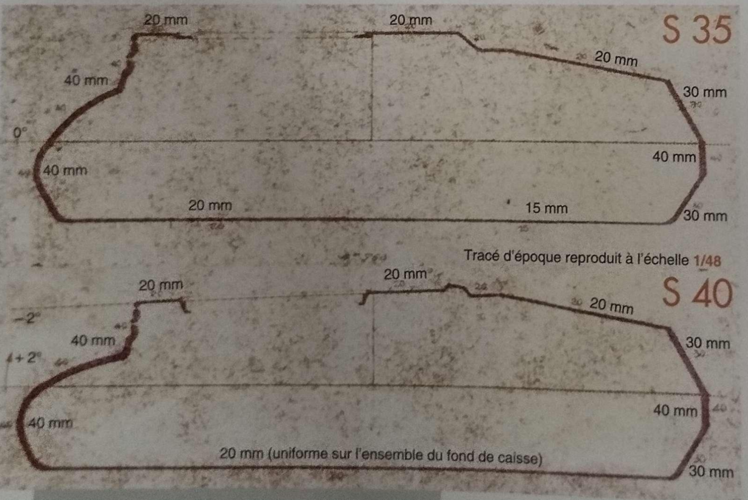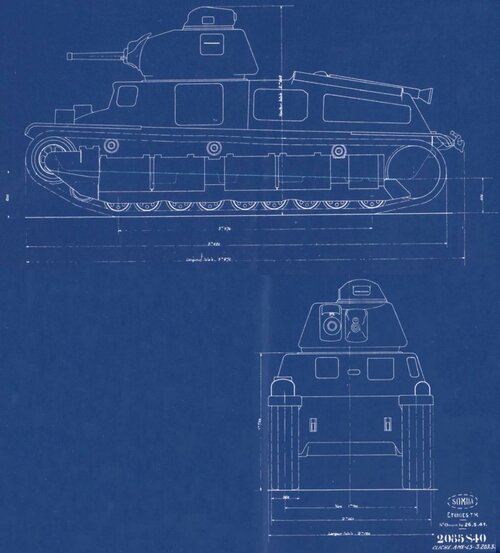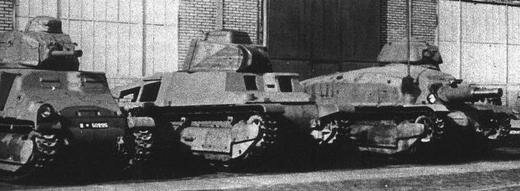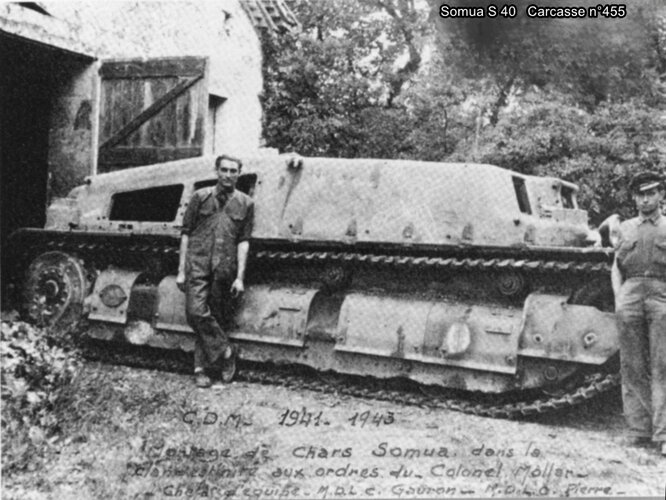Elan Vital
ACCESS: Secret
- Joined
- 6 September 2019
- Messages
- 333
- Reaction score
- 761
Hi everyone,
This thread will be about unbuilt variants of the Somua S35 family, in the same vein as my previous thread about Keller program vehicles, based in part on my research at the Vincennes archives.
This will include (as of current knowledge):
- Somua S40
- Somua S40 with FCM multi-man turrets
- SARL 42
- Somua SAu 40
- other Somua S35-based SPGs.
I will be starting with the FCM turret projects for a modified Somua S40.
Work on these projects is explained in a descriptive note from the 24th of April 1942 from the FCM (Mediterranean Foundries and Shipyards), based notably in Marseille. Here is a translation of the note:
A - Project of 2-man turret with 47mm SA 35 gun.
1°) Mandatory conditions
- Turret ring of 1505mm (ball center distance), fitting within a 1490/1605mm wide hole
- Electric and manual traverse mechanism
- Turret body armored at 40mm on all plates but the roof and floor which are 20mm thick.
- Armament: 1 47mm SA 35 gun with a coaxial 7.5mm machinegun
- AA armament: twin 7.5mm machineguns with increased rate of fire (author's note: analogous to the aircraft MAC 34 M39 machineguns)
- Crew: 2 men: 1 commander with an observation cupola located on the right of the guns with a hatch to observe directly outside, and a gunner located on the left.
- Communication means: radio, signal flags and openings
2°) Description
The turret body is made of rolled armor plates, bent and assembled with joint covers or welding.
The mantlet and the cupola are made of rolled, stamped and welded plates.
The turret body is mounted on a turret ring placed in an opening of the tank's roof.
Turret traverse is done with a manual mechanism or an electric motor.
The controls are doubled so that both the gunner and commander can traverse the turret.
The armament is composed of a 47mm SA35 gun coupled with a coaxial 7.5mm MAC 34 machinegun with a firerate reducer which brings the ROF back down to 600 rpm.
The main gun can be shot with a manual or electric trigger.
AA defense is done by the tank commander who has a twin mount of MAC 34 machineguns firing at 1200rpm each. Elevation angles are from 0 to 80° above the horizontal plane.
The means of observation are as follows:
- for the commander: 3 PPL episcopes with a total forward field of view of 180°, 4 vision slits, one aiming sight and one target designation sight.
- For the gunner: 1 Gundlach periscope, 2 vision slits and one aiming sight.
20 rounds of 47mm ammunition and 15 MG magazines are stored in the turret itself.
Good comfort is ensured by a turret basket in which access to the different observation levels is obtained by adjustable floors.
The turret can be accessed from inside the tank and from the observation hatch on the roof.
The weight of the turret without the basket and ammunition is roughly 3800kg.
B - Project of a 3-man turret with 47mm SA37 gun.
The first project can mount a 47mm SA37 gun instead of the SA35 gun. In this case, proper servicing of the weapon requires a 3-man crew: 1 commander designating targets and ensuring continuity of observation, one gunner and one loader.
The project has been established to fulfill these requirements without modification of the turret basket and traverse mechanism..
The commander and gunner are located on the left of the weapons which are moved slightly further right.
The loader is on the right of the weapons.
The weight of this turret is similar to that of the 2-man turret.
The pictures of the turret are the first accessible in Part 1 of my Vincennes archives album:
Sadly, this was my very first visit there so the quality on those was less than stellar. Higher quality ones are in spoilers


My observations on the plans:
- the 3-man SA37 turret carried 24 ready rounds rather than 20.
- the AA twin MG mount was stored inside the turret near the cupola's hatch, with a mechanism to lift it over the hatch.
- the 2-man turret is 1870mm long, 1670mm wide, and 865mm tall (a little taller than the APX-1 CE on S35 and early S40).
- the inside diameter of the turret ring, so the real diameter accessible to the crew, was 1435mm or 56.5 inches, so a little bigger than/comparable to the T-34-76 and many British tanks of the time with a turret ring diameter of 54 inches.
- a complete revolution of the turret could be done in 20s (18°/s) with the electric motor, 1min20s with the manual mechanism.
- complete weight with the aluminium turret basket and ammunition was 4373 kg. In comparison the APX 1 CE weighed 2000-2200kg fully loaded (not sure if everything is included), so in the most pessimistic esimate the turret would have added 2.2 tonnes to the weight of the S40, notwithstanding the weight increase/reduction caused by modifications to the hull.
It is not known what modifications would be needed on the S40's hull to accept the larger turret ring, nor what modifications were contemplated unrelated to the new turret itself. However, the location of the radio in the turret all but guarantees that the radioman located in the hull of the S35/40 would be removed in favor of...something else.
This project had been apparently done in the context of restarting production of the Somua S40 in Vichy France for the Axis in 1942. Nothing came of this until the invasion and occupation of this part of the country after November 1942.
Overall, the FCM turret project was a natural follow-on to the projects that had been undergoing since before the Fall of France for turrets using welded and bent rolled plates rather than castings, and fixed observation cupolas instead of small rotating cupolas like the cast APX turrets. Both FCM and ARL (the latter with patents and major contribution from the Five-Lilles steelworks) had been designing 1-man turrets to replace the APX-1/4 cast turrets, with introduction starting in July 1940.
It was claimed by a well-known French historian, Stéphane Ferrard, that work on such a type of 3-man turret had started at FCM in April 1940, but to this date I cannot confirm this claim.
It is interesting to note that, unrelated to this program, a report on the lessons of the battle of France and on the creation of a new armored division written in 1940/41 envisionned the use of Somua derivatives with a 2/3-man 47mm turret and a 75mm turret, which are eerily similar to this project and the clandestine SARL 42. It is quite possible that thinking from armored officers inspired these programs or that this simply was convergent evolution.
Regardless, the FCM project was a logical way of using the limited French tank production capabilities which may have been accessible to France in the case of a program approved by the Axis authorities or launched after a very early liberation of France. It allowed the use of a well-known chassis that would be easier to put back in production, while adressing many of the problems of the Somua: it brought one or even 2 crew members in the turret, improved observation capabilities, added a more practical access hatch and more ready ammunition and greatly improved antitank capability in the case of the 3-man turret (to the level of a Pz III with a 5cm L60 gun).
This tank would obviously have been obsolescent from day one by the standards of major powers even if it could enter production in 1943, as it retained now very thin 40mm armor, and modest level of mobility (potentially fast, but only around 10 hp/t). Nonetheless, for non-German Axis powers and co-belligerents like Italy, Hungary or Romania, it was better than nothing and could even compete with a lot of their designs, like the M15/42 which was no better armored, nor more mobile, and more poorly armed, or the Turan I/II which also had poorer antitank capability and barely better armor and mobility. Whether this could have been an actual net gain for the Axis considering their production capability and ressources is however very uncertain.
This thread will be about unbuilt variants of the Somua S35 family, in the same vein as my previous thread about Keller program vehicles, based in part on my research at the Vincennes archives.
This will include (as of current knowledge):
- Somua S40
- Somua S40 with FCM multi-man turrets
- SARL 42
- Somua SAu 40
- other Somua S35-based SPGs.
I will be starting with the FCM turret projects for a modified Somua S40.
Work on these projects is explained in a descriptive note from the 24th of April 1942 from the FCM (Mediterranean Foundries and Shipyards), based notably in Marseille. Here is a translation of the note:
A - Project of 2-man turret with 47mm SA 35 gun.
1°) Mandatory conditions
- Turret ring of 1505mm (ball center distance), fitting within a 1490/1605mm wide hole
- Electric and manual traverse mechanism
- Turret body armored at 40mm on all plates but the roof and floor which are 20mm thick.
- Armament: 1 47mm SA 35 gun with a coaxial 7.5mm machinegun
- AA armament: twin 7.5mm machineguns with increased rate of fire (author's note: analogous to the aircraft MAC 34 M39 machineguns)
- Crew: 2 men: 1 commander with an observation cupola located on the right of the guns with a hatch to observe directly outside, and a gunner located on the left.
- Communication means: radio, signal flags and openings
2°) Description
The turret body is made of rolled armor plates, bent and assembled with joint covers or welding.
The mantlet and the cupola are made of rolled, stamped and welded plates.
The turret body is mounted on a turret ring placed in an opening of the tank's roof.
Turret traverse is done with a manual mechanism or an electric motor.
The controls are doubled so that both the gunner and commander can traverse the turret.
The armament is composed of a 47mm SA35 gun coupled with a coaxial 7.5mm MAC 34 machinegun with a firerate reducer which brings the ROF back down to 600 rpm.
The main gun can be shot with a manual or electric trigger.
AA defense is done by the tank commander who has a twin mount of MAC 34 machineguns firing at 1200rpm each. Elevation angles are from 0 to 80° above the horizontal plane.
The means of observation are as follows:
- for the commander: 3 PPL episcopes with a total forward field of view of 180°, 4 vision slits, one aiming sight and one target designation sight.
- For the gunner: 1 Gundlach periscope, 2 vision slits and one aiming sight.
20 rounds of 47mm ammunition and 15 MG magazines are stored in the turret itself.
Good comfort is ensured by a turret basket in which access to the different observation levels is obtained by adjustable floors.
The turret can be accessed from inside the tank and from the observation hatch on the roof.
The weight of the turret without the basket and ammunition is roughly 3800kg.
B - Project of a 3-man turret with 47mm SA37 gun.
The first project can mount a 47mm SA37 gun instead of the SA35 gun. In this case, proper servicing of the weapon requires a 3-man crew: 1 commander designating targets and ensuring continuity of observation, one gunner and one loader.
The project has been established to fulfill these requirements without modification of the turret basket and traverse mechanism..
The commander and gunner are located on the left of the weapons which are moved slightly further right.
The loader is on the right of the weapons.
The weight of this turret is similar to that of the 2-man turret.
The pictures of the turret are the first accessible in Part 1 of my Vincennes archives album:


My observations on the plans:
- the 3-man SA37 turret carried 24 ready rounds rather than 20.
- the AA twin MG mount was stored inside the turret near the cupola's hatch, with a mechanism to lift it over the hatch.
- the 2-man turret is 1870mm long, 1670mm wide, and 865mm tall (a little taller than the APX-1 CE on S35 and early S40).
- the inside diameter of the turret ring, so the real diameter accessible to the crew, was 1435mm or 56.5 inches, so a little bigger than/comparable to the T-34-76 and many British tanks of the time with a turret ring diameter of 54 inches.
- a complete revolution of the turret could be done in 20s (18°/s) with the electric motor, 1min20s with the manual mechanism.
- complete weight with the aluminium turret basket and ammunition was 4373 kg. In comparison the APX 1 CE weighed 2000-2200kg fully loaded (not sure if everything is included), so in the most pessimistic esimate the turret would have added 2.2 tonnes to the weight of the S40, notwithstanding the weight increase/reduction caused by modifications to the hull.
It is not known what modifications would be needed on the S40's hull to accept the larger turret ring, nor what modifications were contemplated unrelated to the new turret itself. However, the location of the radio in the turret all but guarantees that the radioman located in the hull of the S35/40 would be removed in favor of...something else.
This project had been apparently done in the context of restarting production of the Somua S40 in Vichy France for the Axis in 1942. Nothing came of this until the invasion and occupation of this part of the country after November 1942.
Overall, the FCM turret project was a natural follow-on to the projects that had been undergoing since before the Fall of France for turrets using welded and bent rolled plates rather than castings, and fixed observation cupolas instead of small rotating cupolas like the cast APX turrets. Both FCM and ARL (the latter with patents and major contribution from the Five-Lilles steelworks) had been designing 1-man turrets to replace the APX-1/4 cast turrets, with introduction starting in July 1940.
It was claimed by a well-known French historian, Stéphane Ferrard, that work on such a type of 3-man turret had started at FCM in April 1940, but to this date I cannot confirm this claim.
It is interesting to note that, unrelated to this program, a report on the lessons of the battle of France and on the creation of a new armored division written in 1940/41 envisionned the use of Somua derivatives with a 2/3-man 47mm turret and a 75mm turret, which are eerily similar to this project and the clandestine SARL 42. It is quite possible that thinking from armored officers inspired these programs or that this simply was convergent evolution.
Regardless, the FCM project was a logical way of using the limited French tank production capabilities which may have been accessible to France in the case of a program approved by the Axis authorities or launched after a very early liberation of France. It allowed the use of a well-known chassis that would be easier to put back in production, while adressing many of the problems of the Somua: it brought one or even 2 crew members in the turret, improved observation capabilities, added a more practical access hatch and more ready ammunition and greatly improved antitank capability in the case of the 3-man turret (to the level of a Pz III with a 5cm L60 gun).
This tank would obviously have been obsolescent from day one by the standards of major powers even if it could enter production in 1943, as it retained now very thin 40mm armor, and modest level of mobility (potentially fast, but only around 10 hp/t). Nonetheless, for non-German Axis powers and co-belligerents like Italy, Hungary or Romania, it was better than nothing and could even compete with a lot of their designs, like the M15/42 which was no better armored, nor more mobile, and more poorly armed, or the Turan I/II which also had poorer antitank capability and barely better armor and mobility. Whether this could have been an actual net gain for the Axis considering their production capability and ressources is however very uncertain.






